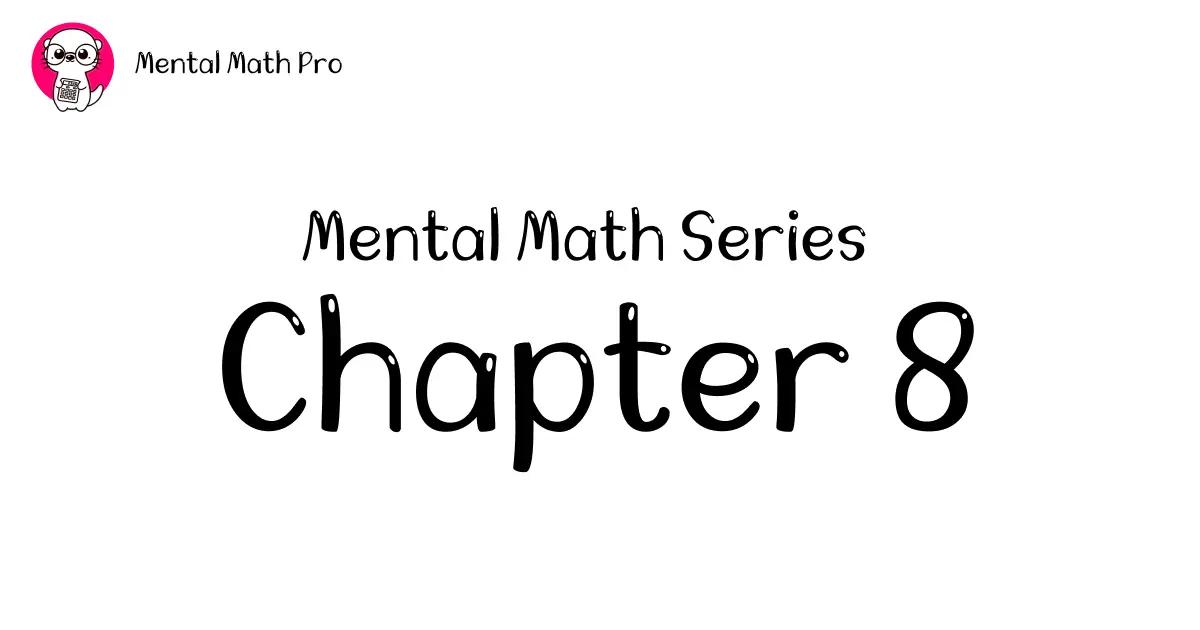Vedic Math Formulas: The Complete List of Sutras
7 min read · Aug 12, 2024

Table of contents
Hey there!
Welcome to the eighth chapter in my mental math series.
Today, we're going to explore those Vedic Math formulas we've been talking so much about.
The 16 Sutras of Vedic Mathematics
Overview of Sutras
The 16 sutras form the backbone of Vedic Mathematics.
These sutras are not mere formulas in the conventional sense; rather, they are word-formulae expressed in Sanskrit.
Each sutra encapsulates a principle or method of calculation, providing a concise and memorable aphorism that guides you through various mathematical operations.
What makes these sutras so special is their versatility. Let's explore them.
List and Brief Explanation of the 16 Sutras
Sidenote: I won't teach each sutra in detail (that would take an entire course). But if a Vedic Math course is what you want (similar to my traditional Mental Math course), let me know!
-
Ekadhikena Purvena (By one more than the previous one): This one's a gem for squaring numbers ending in 5. Say you want to square 25. Look at the previous digit (2), multiply it by one more than itself (3), and you get 6. Slap 25 on the end, and bam! 625. That's 25 squared, quick and easy.
-
Nikhilam Navatashcaramam Dashatah (All from 9 and the last from 10): Use this when you're multiplying numbers close to 10, 100, or 1000. It's all about working with the difference, making big number multiplication a breeze.
-
Urdhva-Tiryakbyham (Vertically and crosswise): This is your go-to for general multiplication. It involves cross-multiplication and vertical addition. Great for big numbers and even algebra.
-
Paraavartya Yojayet (Transpose and adjust): This one's a lifesaver for division problems and quadratic equations. It gives you a whole new way to approach these tricky areas.
-
Shunyam Saamyasamuccaye (When the sum is the same, that sum is zero): Helpful for certain equations where everything adds up to zero. It's like finding balance in your calculations.
-
Anurupye Shunyamanyat (If one is in ratio, the other is zero): This one's all about proportions and equations. It's particularly useful in scenarios where one quantity is proportionally related to another.
-
Sankalana-vyavakalanabhyam (By addition and by subtraction): Use this for solving simultaneous equations by strategically adding or subtracting them.
-
Puranapuranabhyam (By the completion or non-completion): This one's for multiplication and division. It involves breaking down numbers into parts for easier calculation.
-
Chalana-Kalanabyham (Differences and Similarities): This one's for the big leagues - differential calculus. It's about finding derivatives.
-
Yaavadunam (Whatever the extent of its deficiency): Great for quadratic equations. It's all about working with what's missing or extra in a problem.
-
Vyashtisamasthi (Part and Whole): Use this for equations and factorization. It leverages the relationship between parts and the whole to simplify complex problems.
-
Shesanyankena Charamena (The remainders by the last digit): This one's for finding remainders and checking divisibility. Quick and dirty tricks for common math operations.
-
Sopaantyadvayamantyam (The ultimate and twice the penultimate): Another quadratic equation solver. It gives you a unique angle on these problems.
-
Ekanyunena Purvena (By one less than the previous one): Helpful in factorization and solving equations. It offers another perspective on number relationships.
-
Gunitasamuchyah (The product of the sum is equal to the sum of the product): Use this for multiplication and proving algebraic identities. It reveals interesting properties of sums and products.
-
Gunakasamuchyah (The factors of the sum is equal to the sum of the factors): Great for factorization and solving equations. It gives you insights into factors and sums.
These sutras provide a comprehensive toolkit for approaching various mathematical problems.
Master these, and you'll have a whole new toolkit for tackling math problems.
The 13 Sub-Sutras
These are like the sidekicks to our main 16 sutras.
They complement and enhance the application of the main sutras.
-
Anurupyena (Proportionality): This one's gold for solving proportion problems and ratios. It's like having a built-in calculator for tricky percentage questions.
-
Sheshaanyankena Charamena (The remainders by the last digit): Want to find remainders quickly? This is your go-to. It's all about the relationship between a number's last digit and its remainder.
-
Aadyamaadhyena Antyamaadhyena (The first by the first and the last by the last): Use this when you're multiplying numbers with the same number of digits. This sub-sutra offers a quick method for certain types of multiplication.
-
Kevalaih Saptakam Gunyat (When multiplied by 7): Got to multiply by 7? This sub-sutra's got your back. It's a niche skill, but it'll come in handy more often than you'd think.
-
Vestanam (By Osculation): This one's for squaring numbers near multiples of 10. It offers a quick method for mental calculation of squares.
-
Yaavatdunam Taavatdunam (By deficiency or excess): Use this when you're multiplying numbers near 10 or 100. It's all about working with the difference, making big multiplications a breeze.
-
Yaavatdunam Taavatdunikritya Vargacha Yojayet (Whatever the deficiency, multiply that by itself and add): Another gem for squaring numbers near multiples of 10. It's like a mental shortcut for your mental shortcuts.
-
Antyayordasake'pi (Last totaling 10): This one's for when you're multiplying and the last digits add up to 10. It's a specific case, but when it applies, it's lightning fast.
-
Antyayoreva (Only the last terms): Use this when you're multiplying numbers with the same number of digits. It's about focusing on the last terms to simplify the process.
-
Samucchayagunitah (The sum of the coefficients in the product): This one's for the algebra whizzes. It helps you figure out coefficients in multiplication without breaking a sweat.
-
Lopanasthapanabhyam (By alternate elimination and retention): Got simultaneous equations? This sub-sutra will help you solve them by systematically eliminating and keeping terms.
-
Vilokanam (By mere observation): This sub-sutra encourages you to simplify and observe carefully, often leading to quicker solutions.
-
Gunitasamuchyah Samuchayagunitah (The product of the sum is equal to the sum of the product): Use this for certain types of multiplication, especially with algebraic expressions.
Again, these sub-sutras aren't meant to be used in isolation.
Use them in conjunction with the main sutras, and you'll have a comprehensive toolkit for solving a wide range of mathematical problems quickly and efficiently.
Detailed Explanations and Examples of Key Sutras
Alright, let's roll up our sleeves and dive into some of the key sutras with detailed explanations and examples.
Ekadhikena Purvena
This sutra means "by one more than the previous one," and it's your secret weapon for squaring numbers ending in 5. Let me show you how it works:
Step-by-Step Example: Let's square 45:
- The last part of our answer is always 25 (that's 5 squared).
- Look at the digit before 5 (that's 4).
- Multiply 4 by the next number up (4 + 1 = 5): 4 × 5 = 20
- Slap 20 and 25 together: 2025
Just like that, 45² = 2025
It works for any number ending in 5! Let's try 105:
- Last part? 25.
- Before the 5, we've got 10.
- 10 × 11 = 110
- Put 110 and 25 together: 11025.
Boom! 105² = 11025
This sutra is like a magic trick for your brain. It's fast, it's simple, and it'll make you look like a math wizard.
Nikhilam Navatashcaramam Dashatah
This sutra, which translates to "All from 9 and the last from 10," is a mouthful, but it's gold for multiplying numbers close to a base (usually a power of 10).
Step-by-Step Example: Let's multiply 94 and 92:
- Our base is 100 (closest power of 10).
- Find the differences:
- 94 is 6 less than 100 (-6)
- 92 is 8 less than 100 (-8)
- Multiply these differences: (-6) × (-8) = 48
- Subtract diagonally:
- 94–8 = 86 or 92–6 = 86
- Put it together: 86|48
There you have it: 94 × 92 = 8648
This method is especially handy for mental calculations involving numbers close to 100, 1000, or other powers of 10.
Urdhva-Tiryakbyham
This sutra means "vertically and crosswise," and it's a versatile method for multiplying numbers of any size.
Step-by-Step Example: Let's multiply 32 by 14:
- Multiply the right digits vertically: 2 × 4 = 8
- Multiply crosswise and add: (3 × 4) + (2 × 1) = 12 + 2 = 14
- Multiply the left digits vertically: 3 × 1 = 3
- Put it all together, carrying over when needed:
- Right: 8
- Middle: 14 (carry 1 to the left)
- Left: 3 + 1 (carried) = 4
And there you have it: 32 × 14 = 448
This method is versatile. You can use it for big numbers, small numbers, even algebra.
Paravartya Yojayet
This one means "transpose and apply," and it's your secret weapon for division when the divisor is just a bit more than a power of 10.
Step-by-Step Example: Let's divide 1225 by 12:
- Write 12 (divisor) and -2 below it.
- Write 1225 (dividend) to the right, leaving 5 as remainder.
- Divide 1 by 1, write the result below. Multiply by -2 and subtract from the second digit.
- Keep going for the rest.
You'll end up with 102 and a remainder of 1.
So, 1225 ÷ 12 = 102 with a remainder of 1.
This method turns long division from a chore into a breeze.
Anurupye Shunyamanyat
This one means "If one is in ratio, the other is zero." It's your go-to for problems with proportions and ratios.
Step-by-Step Example: Let's solve 2/x = 3/6
- Set it up: 2/x = 3/6
- Cross multiply: 2 * 6 = 3 * x
- Simplify: 12 = 3x
- Solve: x = 12/3 = 4
Just like that, we know x = 4.
This sutra is like a Swiss Army knife for proportions. You can use it in math, physics, chemistry, even finance. It's all about seeing the relationships between numbers and using them to your advantage.
Conclusion
Remember, these 16 sutras and 13 sub-sutras aren't just about being faster at math. They're about understanding numbers on a deeper level.
I hope this chapter helped you have a deeper appreciation for their value.
See you in the next chapter 🙂 Be well.
About the author

Richard Reis
Founder of Mental Math Pro! Also currently doing a fun little "25 AI Startups in 50 Weeks" challenge.


